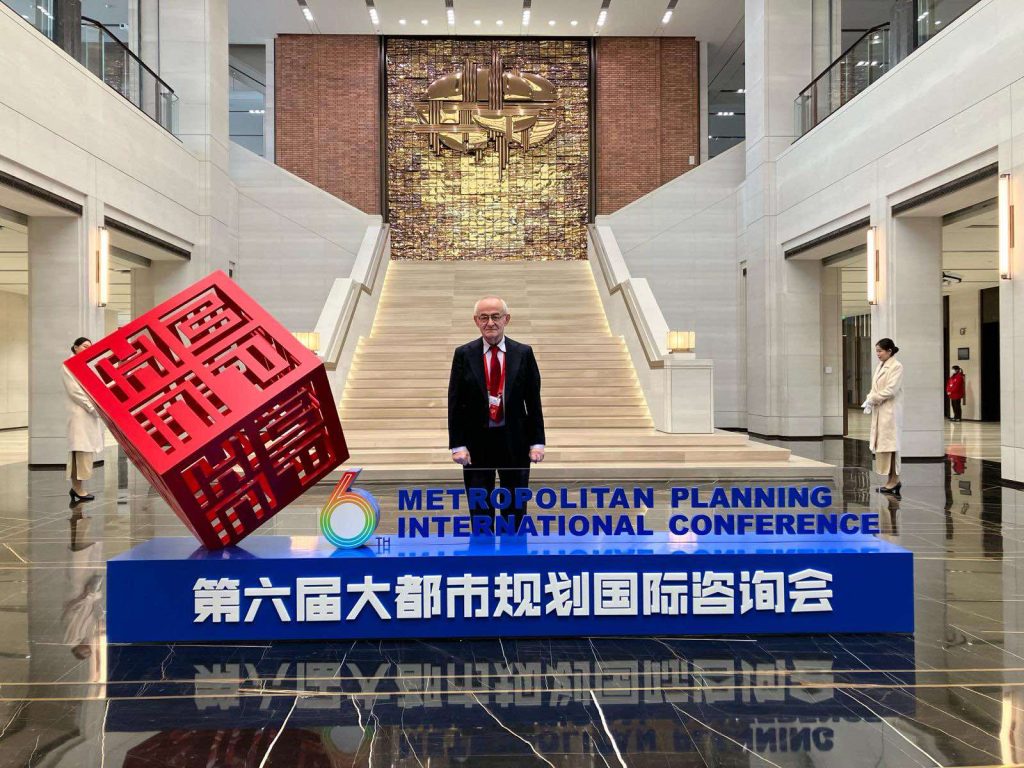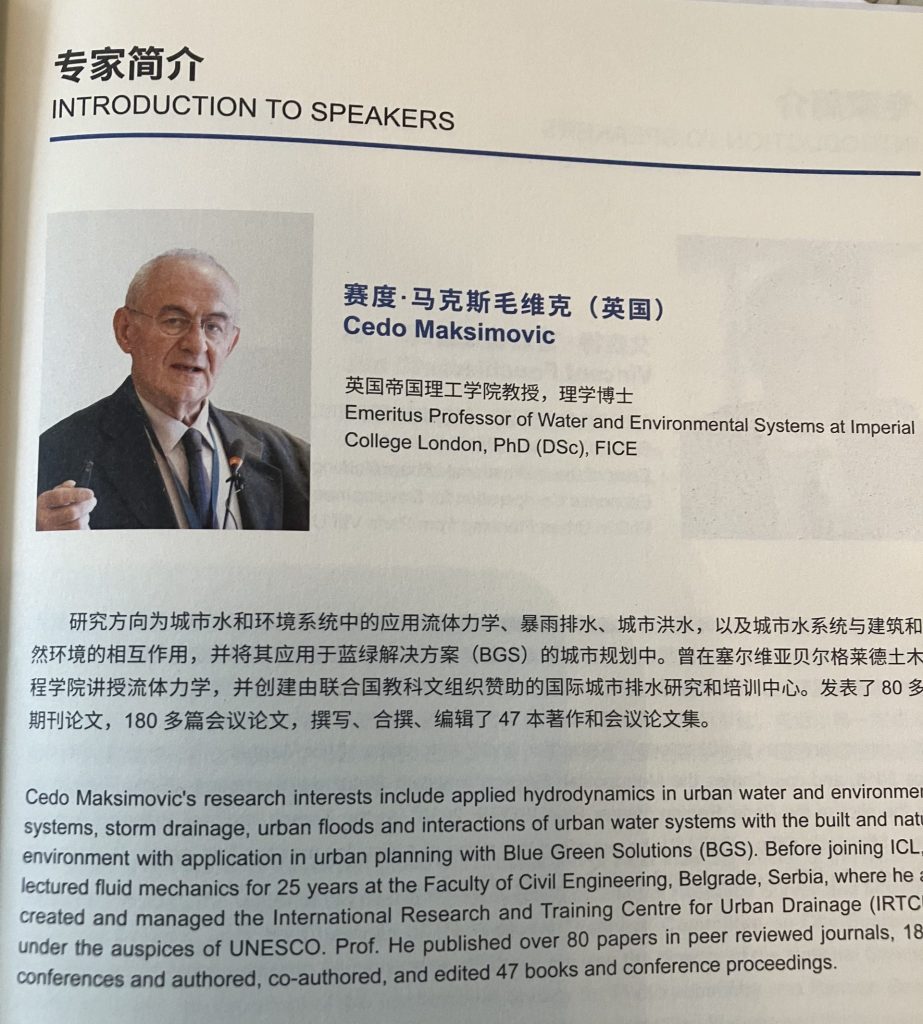euPOLIS Philosophy for Planning Humane Megacities
One of the euPOLIS key experts, professor emeritus at the Imperial College London, Čedo Maksimović, the technical coordinator of the euPOLIS project, on 30th November presented the project methodology and its applicability in China with the outlook to other cities in and outside of Europe.
At the Metropolitan Forum in Shanghai, professor Maksimović gave a keynote lecture on recent developments in advanced – innovative urban-spatial planning and design based on BGS (Blue Green Solutions, also called NBS, Nature Based Solutions), developed under the presenter’s coordination through Imperial College London, within several EU projects including the ongoing euPOLIS and HEART. It aimed to add value and enhancement to the Shanghai 2035 Master Plan/Urban Planning Vision and its further development and gradual implementation beyond the coming decades.

The Municipality of Shanghai is also proposed to replace Fengxi New City as an FL city in the euPOLIS project.
Shanghai Municipal Bureau of Planning and Natural Resources, Tongji University, and the China Land Surveying and Planning Institute, under the guidance of the Ministry of Natural Resources and the Shanghai Municipal People’s Government, jointly hosted the 6th Metropolitan Planning International Conference (MPIC), with the theme “Megacity Development: Challenges and Future”.
This event from late November/early December 2023 brought together guests, experts, and scholars from global metropolitan planning administrations, academic and research institutions, as well as consulting think tanks in planning to foster exchanges and dialogues on the challenges and opportunities in metropolitan planning. It aimed to become a vital communication and sharing platform for promoting the exchanges of planning consultation among international metropolises and an international strategic planning platform conducive to the implementation of the “Shanghai 2023” Master Plan, which is planned to become the beacon (lighthouse) for the future planning of the other cities in China and beyond.
Besides prof. Maksimović, the other two keynote speakers were Dr. Vincent Fouchier from France, Director of the Aix-Marseille-Provence metropolitan area planning project, and chief urban planner of the Shanghai 2035 Master Plan Peng Zhihwei, The key plenary session in which these 3 keynote lectures were delivered, was hosted by Gong Zheng the mayor of Shanghai.
Prof Maksimović with the Mayor of Shanghai Gong Zheng who chaired the plenary session and Zhang Xiaihong deputy mayor, the host of the official dinner
In his keynote speech, prof. Maksimović highlights:
“The concept of innovative planning and design pursues critical evaluation of the existing paradigm which often enlists WHAT should be done but lacks consistency on HOW. It introduces its change comprehensive monitoring of the existing situations’ shortcomings, by modeling, quantifying, and optimizing potential synergies between BGS, the local built environment, including potential benefits, water, green, grey, and other infrastructure, and ESS (ecosystem services) under the impacts of climate changes, addressing the needs of the future cities to provide better public health and wellbeing and deliver attractive world-class urban environment’s vital restorative potential with lower life-cycle costs. It provides crucial insights into how cities can harness the power of nature to meet the challenges of the future through multifunctional concepts.
By introducing advanced diagnostics of the existing urban systems to tackle their sub-optimal use of land, water, energy, and other resources, environmental degrading, and negative impacts on liveability and people’s health. BGS concept introduces its genuine/bespoke system of Goal Driven Planning Matrixes (GDPM), related guidelines for its application in innovative BGS-compliant design, and its customization for implementation in the Shanghai environment, but also to be made scalable to other cities in China. Some concrete suggestions are made for the implementation of GDPM and its “derivatives” – planning /design guidelines to address the problems, strategies, and challenges of Shanghai’s metropolitan area. These examples will include but are not limited to:
- Potentials for vacating large urban land areas (footprint of the existing WWTPs / wastewater treatment plants) by introducing advanced technologies with a much smaller footprint and other multiple savings and use of this “freed land” for the “next generation” city mini clusters designed work, offices, residential, education, trading, primary entertainment and culture, etc within “walking distances”; with large liveability/life quality improvement, energy and money saving.
- Reverse the order of transport diversification e.g. Introducing reduction of the transport needs by regrouping between residential and working facilities before diversification.
- Introduce HCPM (Health Centred Planning Matrix) in planning, designing, and proactive management of open urban spaces for boosting the urban population’s health.

Furthermore, to achieve the Masterplan’s 3 priorities, and promote Shanghai as an Innovative, Humanistic, and Sustainable City both on a neighborhood and global level, a coordinated simultaneous interdisciplinary and holistic mix of city-making and co-creation approaches is proposed to amplify and multiply complex vision of an excellent global City. It introduces innovative and flexible models of living and working for (young) creative forces and cultural (“third places”, experimental living labs, creative/community hubs), and shared economy formats, and thus sets the new standards of place-making in the global arena. Shanghai will develop an advanced multi-stakeholder communication and City co/creation platform as a new standard mapping diverse citizens’ needs, to voices of the sensitive ones.”
Contributions from Mrs. Maja Lalić (Mikser) and Mr. Ranko Boživić (En Plus) are highly appreciated!
Furthermore, on this occasion, Professor Maksimović was also invited by the CAEP (China Academy for Environmental Planning) to resume his role as the Chief Advisor for the next phase of remediation of the Green Heart Park in Tongzhou, the new affiliated capital (replacing Beijing). This park is located in the area that used to be a large petrochemical industry complex that suffered an industrial accident during which a large amount of chemical pollutants ended up in the groundwater IGW) aquifer. Before Covod, Maksimović had completed a study on specific aspects of Green Heart Park rehabilitation management which included the use of phytoremediation for speeding up the uptake of pollutants from GW and soil, which are still the major source of air pollution emissions.



